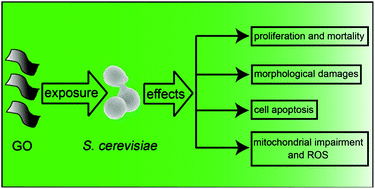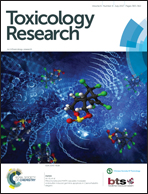Toxicological effects of graphene oxide on Saccharomyces cerevisiae
Abstract
Using Saccharomyces cerevisiae as an experimental model, the potential toxicity of graphene oxide (GO) was evaluated following exposure to 0–600 mg L−1 for 24 h. The results showed that cell proliferation was observably inhibited and the IC50 value was 352.704 mg L−1. Mortality showed a concentration-dependent increase, and was 19.3% at 600 mg L−1. A small number of cells were deformed and shrunken after exposure. The percentage of late apoptosis/necrosis showed a significant increase (p < 0.01) at 600 mg L−1 (19.16%) compared with the control (1.14%). The mitochondrial transmembrane potential was significantly decreased (p < 0.01) at 50–600 mg L−1, indicating that the apoptosis was related to mitochondrial impairment. Moreover, ROS was observably increased (p < 0.01) at 200, 400 and 600 mg L−1. The expressions of apoptosis-related genes (SOD, Yca1, Nma111 and Nuc1) were significantly changed. The results presented so far indicate that GO has the potential to cause adverse effects on organisms when released into the environment.



 Please wait while we load your content...
Please wait while we load your content...